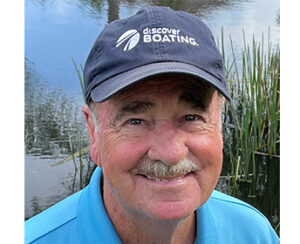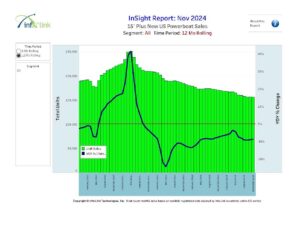
Boat registration totals for July mostly revealed considerable weakness compared with a year earlier, and tumbled back into a steeper downtrend than the prior month’s comparisons.
Total-industry recreational boat registrations declined by 14.2 percent in July compared with July 2021 totals, according to monthly data compiled by Statistical Surveys, a Michigan firm that tracks new-boat registrations.
The year-over-year monthly declines exceeded 20 percent in six of the 15 vessel categories that Statistical Surveys follows. Personal watercraft registrations were 27.8 percent below July 2021 totals. Sterndrive/inboard cruisers dropped by 26.7 percent, followed by the all-yacht tally (24.5 percent lower) and then aluminum fish and aluminum general recreation boats, down 21.3 percent and 21.2 percent, respectively.
Many of the weakest categories rely on lower-income buyers struggling with record-high gasoline prices and other inflationary problems, according to Michael Swartz, a recreation and leisure analyst at Truist Securities. “There is a bifurcation in the market,” Swartz says. “The lower end is very soft. That’s where you see impact of inflation on the blue-collar consumer. Offshore fishing boats and yachts seem to be holding on pretty strong.”
Four categories managed increases in July, notably electric boats, which leaped by 38.9 percent. Also increasing in registrations were jetboats, the largest yachts and the “all others” powerboat segment.
The July totals came in from 36 states, representing 77.1 percent of the U.S. boat market, according to Statistical Surveys.
Electric boats are a “secular growth area,” Swartz says. “There’s something clearly going on there. As more people come out with electric outboard technology, not really for offshore but for fresh water and the fleet-based businesses and the rental clubs, you’re going to continue to see that grow.”
June registration totals from Statistical Surveys also included increases in certain categories of yachts and jetboats. Swartz says some of those improvements may represent catch-up after registration delays in regions where the boating season was postponed because of inclement spring weather.
The main powerboat segments declined in July by a combined 9.1 percent after also underperforming June, when the decline was 5 percent. The sail category, which has mostly shown strength throughout 2022, was down 1.4 percent in July after rising 12.1 percent in June.
Subsequent months are likely to show a rebound and continuous improvement for overall boat registrations, says Swartz, who is also Truist’s director of equity research. Manufacturers are making better progress in their backlogged order fulfillment for new boats. Much of the boatbuilders’ current output may be shipped to customers in autumn months that are not normally the ideal season to start boating in much of the country and, therefore, historically record fewer registrations.
“The comparisons are going to get easier … in the back half of the year,” Swartz says. “Inventory is starting to come back, and more people will take delivery of their boats,” especially in Sun Belt states where wait-listed customers will be eager to get on the water even in the off-season.
This article was originally published in the October 2022 issue.










